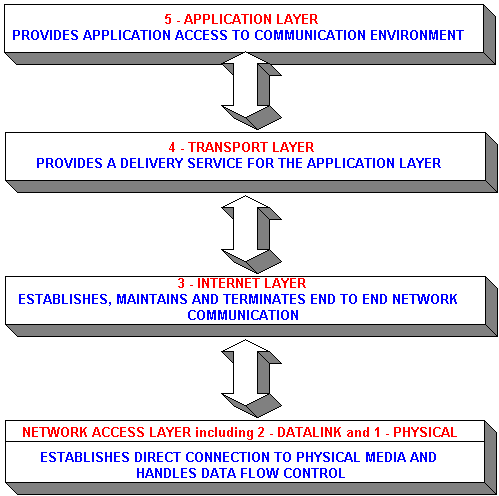![]()
TCP/IP is a suite of protocols, also known as the Internet Protocol Suite. It should not be confused with the OSI reference model, although elements of TCP/IP exist in OSI. The transmission control protocol and the internet protocol are fundamental to the suite, hence the TCP/IP title. The suite was originally developed for the US Department of Defense Advanced Research Project Agency (DARPA) network, but it is now the basis for the Internet and many intranets - such as the Faculty of Information Technology intranet at the University of Brighton.
Research started in the 1970s and the incorporation of TCP/IP into the University of California distribution of Unix hastened exposure to academics and industrialists. The University of California Unix is also known as the Berkeley distribution. The suite formed the basis for the interoperability that is fundamental to distributed computing. It was originally assumed that organisations would use TCP/IP prior to migrating to the newer OSI protocols, although this transition has never really happened.

As with the OSI model, the TCP/IP suite uses a layered model. The OSI model has seven layers, the TCP/IP model has four or five - depending on who you talk to and which books you read!. Some people call it a four layer suite - Application, Transport, Internet and Network Access, others split the Network Access layer into its Physical and Datalink components. This diagram of the suite represents something of a compromise! Some of the protocols that comprise the TCP/IP model are explained further on the TCP/IP Protocols page.
This layer is broadly equivalent to the application, presentation and session layers of the OSI model. It gives an application access to the communication environment. Examples of protocols found at this layer are Telnet, FTP (File Tranfer Protocol), SNMP (Simple Network Management Protocol), HTTP (Hyper Text Transfer Protocol) and SMTP (Simple Mail Transfer Protocol).
The transport layer is similar to the OSI transport model, but with elements of the OSI session layer functionality. This layer provides an application layer delivery service. The two protocols found at the transport layer are TCP (Transmission Control Protocol) and UDP (User Datagram Protocol). Either of these two protocols are used by the application layer process, the choice depends on the application's transmission reliability requirements.
TCP is a reliable, connection-oriented protocol that provides error checking and flow control through a virtual link that it establishes and finally terminates. This gives a reliable service, therefore TCP would be utilised by FTP and SNMP - file transfer and email delivery have to be accurate and error free.
UDP is an unreliable, connectionless protocol that provides data transport with lower network traffic overheads than TCP - UDP does not error check or offer any flow control, this is left to the application process. SNMP uses UDP - SNMP is used to monitor network performance, so its operation must not contribute to congestion.
This layer is responsible for the routing and delivery of data across networks. It allows communication across networks of the same and different types and carries out translations to deal with dissimilar data addressing schemes. IP (Internet Protocol) and ARP (Address Resolution Protocol) are both to be found at the Internet layer.
The combination of datalink and physical layers
deals with pure hardware (wires, satellite links, network
interface cards, etc.) and access methods such as CSMA/CD
(carrier sensed multiple access with collision detection). Ethernet
exists at the network access layer - its hardware operates at the physical
layer and its medium access control method (CSMA/CD)
operates at the datalink layer.
| PC Lube and Tune Introduction to TCP/IP | Basic TCP/IP information |
| Napier University Introduction to TCP/IP | Good resource hosted by Napier's Department of Electronic Engineering |
| National Health Service Electronic Library | The NHS's TCP/IP guide! |
| University of Bradford Introduction to TCP/IP | Extensive FAQ |
| TCP/IP FAQ part 1 , TCP/IP FAQ part 2 | More FAQs from State University of New York, this link is also worth a look |
| SNMP FAQ part1 , SMNP FAQ part 2 | Extensive frequently asked questions from State University of New York |